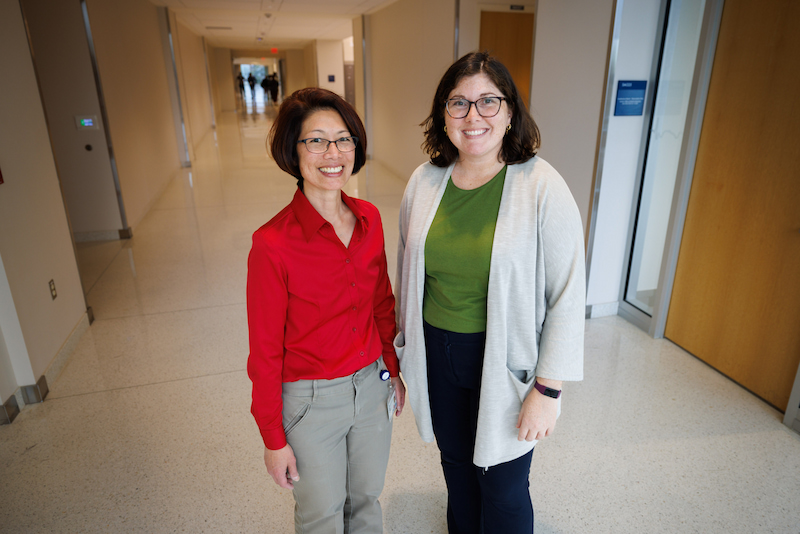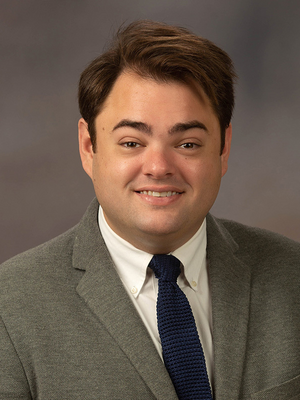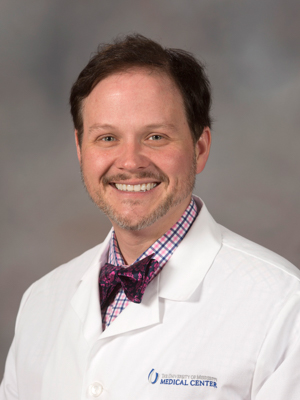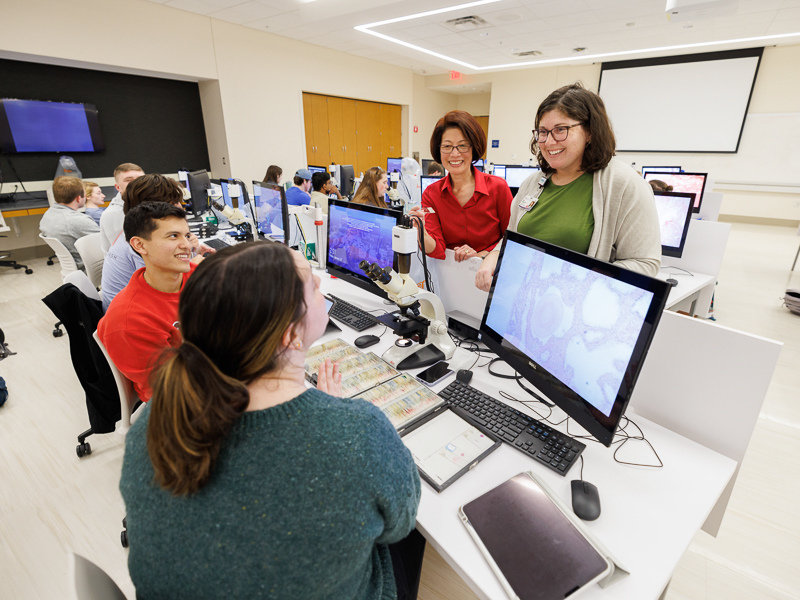Front and Center: Dr. Kathleen Yee and Dr. Audra Schaefer

A change in the way medical students are taught an anatomy course has scored big, boding well for their ability to find and fix their future patients’ problems.
In comparison to previous classes, students now in their third year at UMMC made a striking improvement on scores for the histology section of the “Step 1” exam: the first part of the test all medical students take on the way to earning their medical license.
Much of the credit for the upgrade has gone to Dr. Kathleen Yee, course director for medical and graduate histology and cell biology, and a team of faculty members teaching it, including Dr. Audra Schaefer, assistant professor of advanced biomedical education and the interim director of the Graduate Program in Clinical Anatomy.

“We should recognize them for essentially achieving the impossible,” said Dr. Wesley Wilson, faculty development director in the School of Medicine. “They have driven one of the most significant improvements in our school’s undergraduate curriculum.”
Histology is the study of tissues under a microscope – which is exactly where, figuratively speaking, Yee put traditional teaching methods.
In the past, students could rely heavily on their remarkably good memories to tame one of their toughest hurdles, which students in the School of Graduate Studies in Health Sciences must also clear.

But, as Dr. David Norris put it: “Patients don’t read the textbook. Memorization is a good start, but asking questions that only require recall is not good enough when you’re training future physicians,” said the professor of medicine and assistant dean for academic affairs in the School of Medicine.
“As physicians, we must be able to analyze a problem, going by the way a patient presents, and then fix it.”
So, it became the mission of Yee and the histology faculty to expand students’ exposure to exam questions – “Step 1-type” questions, in fact – which reward that knowhow.
“We don’t want to test students’ memorization skills; we want them to use knowledge they gain about cells, tissues and organs and apply it,” said Yee, an associate professor of otolaryngology-head and neck surgery.
That means, instead of asking for a definition of, say, a certain type of cell, one question might describe a patient’s reaction to a particular medication and ask for the name of the cell whose presence is responsible.
It means not showing students the same images of tissues they’ve seen in the classroom, but instead asking them to identify those same structures in tissue samples that are new to them and, in some cases, from a pathological, or diseased, state.
“It’s about seeing a patient who has certain symptoms and being able to realize what is going wrong in certain tissues,” said Schaefer, who gets feedback from students as she prepares them for test questions.

The strategy was a success, if the recently released 2022 Step 1 Interim Annual School Report means anything. Compared to the national group, on the Histology and Cell Biology section, the percentage of UMMC students who performed the same or higher totaled 78 percent; in each of the previous two years, the total was 61 percent.
The percentage of those who performed higher than the national group was 17, versus seven from the year before. Although these learners are M3s, they took Step 1 at the end of their second year, as do all medical students.
“All of the course faculty challenge the students,” Yee said, “and it’s the students who do the hard work to meet the challenge.”
Yes, it was hard, said M3 Kimberly Gilmore of Jackson, who ranks histology in the Top 3 for most mind-bending. “It was seven credit hours, but it’s so challenging I think the credit hours should increase.
“But Dr. Yee wants you to learn, and you will learn. She and her team were always available and were very fair.”
Yee, who joined the Medical Center in 2011, earned her PhD in neurobiology, anatomy and cellular science at the University of Pittsburgh after training or doing research at such institutions as the University of Cambridge, England; the Salk Institute in California; and the Tufts University School of Medicine in Boston.
Others, namely her peers, have also noticed her teaching talents. They recently nominated her for one of UMMC’s Trailblazer Awards for Excellence in Medical Student Education, which she won. She is applying her excellence to a subject that burdens the brainpower of many bright students.
The challenge of teaching histology, Yee said, is that the students who start the class together may know a little to a lot about the subject. “Some have never had histology before,” she said. “We must try to teach them the tools they need to catch up.”
In which case, she has a valuable colleague in Schaefer, who researches how medical students learn. “That research shapes how I teach,” said Schaefer, who holds a PhD in anatomy and cell biology from Indiana University.
A Medical Center faculty member since 2018, Schaefer won the 2021 and 2022 M1 Basic Science Professor of the Year awards from the Carl G. Evers, MD, Society. It’s saying something that the students who voted on the 2021 award are the current M3s.
“In my lectures, I sprinkle in suggestions for studying,” Schaefer said, “and I tie together the courses in the anatomical sciences – explaining how knowledge of one contributes to another.” That includes pathology, the study of diseases, for which histology lays the groundwork.
Like her histology colleagues, Schaefer connects function to structure when lecturing students. “That is what I love about histology,” she said. “Besides, histology is beautiful.”
For her part, as an imminent physician, Gilmore rates the importance of histology in her future career at “100 percent,” she said. “I’m interested in pediatric gastroenterology.”
In that field, she must, for instance, be able to detect different patterns, to be able to understand the difference between, say, celiac and ulcerative colitis, and to “realize when I’m seeing cells that are not normal,” she said.
To that end, the histology faculty has prepared her well, she said, and, to top it off, they did so during the worst days of COVID-19. “Dr. Yee and her team were able to pivot; they taught us online,” Gilmore said. “Our laptop was our microscope.”
Trying to change the process of teaching in the midst of a pandemic equaled a “double whammy,” Norris said. “The histology faculty has really risen to the challenge.
“Among an already excellent faculty, Dr. Yee and Dr. Schaefer have been shining stars.”
FACULTY, HISTOLOGY AND CELL BIOLOGY
(Taught students who are now M3s; current titles listed)
Dr. Kathleen Yee, associate professor of otolaryngology-head and neck surgery, with a secondary appointment in the Department of Advanced Biomedical Education, course director for medical and graduate histology and cell biology
Dr. Audra Schaefer, assistant professor of advanced biomedical education, interim director of the Graduate Program in Clinical Anatomy.
Dr. Dongmei Cui, associate professor of advanced biomedical education
Dr. Bernadette Grayson, associate professor of neurology
Dr. Matthias Krenn, assistant professor of neurosurgery
Dr. Paul May, professor emeritus of advanced biomedical education
Dr. Douglas Vetter, associate professor of otolaryngology-head and neck surgery
Dr. Bradley Walters, associate professor of otolaryngology-head and neck surgery:
Dr. Keli Xu, associate professor of cell and molecular biology
Read more Front and Center stories online. Do you know a student, staff, volunteer or faculty member at the University of Mississippi Medical Center whose story would make an interesting feature or deserves to be recognized? Think about someone with outstanding job commitment, fascinating hobby or amazing accomplishment.
To nominate someone to be considered for a Front and Center feature, just complete and submit this short form. If that person is picked for a feature, a member of the Communications and Marketing staff will contact him or her to learn more about his or her personal story.


